Take a City Tour!
Here’s a short video to show you around parts of the city in Light Trail Rush. (Not a gameplay video). Enjoy and let us know what you think on https://discord.gg/TxtkWJe
Here’s a short video to show you around parts of the city in Light Trail Rush. (Not a gameplay video). Enjoy and let us know what you think on https://discord.gg/TxtkWJe

Making a game takes a lot of love and sweat.
As an indie dev, deadlines and crunches sometimes prevent us from taking a step back from tasks. So, we thought we’d sit down with team members and have them share their experience on making LTR, from a more personal perspective.
I literally started designing games when I was twelve. In that sense, I was already a game designer without knowing it. My first game was a board game, I tweaked Risk, to make it more interesting, after that, I made Bot Arena, again a board game. It was a combat robot, and each gamer could influence its behaviour. It was later in my career adapted into a video game. It’s only much later that I started making a living as a game designer for Infogrames. I’ve always been a big fan of tabletop role-playing games for which I wrote scripts. And today, I’m an author writing scripts.
A game designer is a magician. We have the privilege of creating portals opening to unique experiences for players to explore.
A great game offers a transformational experience for the player, taking them away from reality. It’s where the magic starts, and in my opinion, a game designer should keep that in mind. And, I consider Magic as an art form.
I believe we’re only at the beginning of video game history. I feel we’re going moving on to what experts call “permanent games”. In other words, pervasive games will be more and more embedded in our real world. Pokemon Go was only a sample of what will happen in a few years. The border between reality and the play is blurred.
In that sense, the responsibility for the game designer in the near future will get much more ethically important.
The most challenging part is game balance. LTR offers multiple gameplay according to whether you’re a Chaser or a Tracer. Your role can switch many times during the game. And the difficult part is to make both experience exciting and rewarding.
Also, as the LTR lore is directly derived from Beyond the Void universe, it comes with constraints for the storytelling. My challenge is to enrich the existing lore. We’re quite proud of the lore telling a story spanning across 7 000 years.
We’re also integrating the blockchain ecosystem into LTR, which comes with many questions in regards to how to offer a seamless experience.
I’ve been practising Chaos Magick for twenty years. I love it. It still helps me to break out from the duality of life. Its practice has greatly influenced my personal life.

Making a game takes a lot of love and sweat.
As an indie dev, deadlines and crunches sometimes prevent us from taking a step back from tasks. So, we thought we’d sit down with team members and have them share their experience on making LTR, from a more personal perspective.
First, I was a gamer, I started playing video games when I was four. My dad initiated me into the games as he was a fan of Super Mario which he played on Nintendo 64. For one Christmas, I got a Gameboy Color with Pokemon, and since, I never let go of my game controller. My life ambition was to be the best Pokemon trainer and beat my brother and sister. Twenty years later, not much has changed, I still play Pokemon. I can be quite persistent.
At thirteen, I started making drawings of the manga Naruto. I’d be drawing and doodling all the time, and I got hooked on the sensation of pride whenever my friends would compliment my production.
I never thought one could study and make a living out of something one loves, in my case: video games and art. I discovered you could work in the video games industry thanks to my mother who knew of a school offering training and careers in the field as an artist. I chose 3D over 2D, the conception of the project in 3D offers many tools and techniques, there is always new stuff to learn. Also, I love the end result, when looking from any angle your 3D art, it’s extremely rewarding.
By the way, to take this further, I want to treat myself to a 3D printer, I’d love to watch my creations brought to life under my eyes in real time and hold them in my hands.
My inspirations come from the games Zelda (Wind Waker, Twilight Princess, Breath of the Wild), and Okami. They feature beautiful art. I love narrative and open world environments. Being given complete navigation freedom and to be able to enjoy a contemplative experience, is a wonderful thing. Each game offers a distinctive artistic direction which takes us to an exciting whole new world, and I love them all.
Although I was a solo gamer for years, I lately moved to online games: Heroes of the storm, League of Legend, overwatch for example. These games also have an exciting artistic direction and I have been influenced by them for my personal projects.
Recently, I’ve been testing a different style, with a more realistic touch, like in Dishonored.
I also take many snapshots of places I visit, I use them later as models, they are my personal data bank.
LTR definitely has been challenging, it made me break out of my comfort zone.
At the moment, I create buildings in 3D, my starting point is the concept of art made by the 2D artist.
It’s a large project for a small studio like us, very greedy in artistic production. I learned new techniques, ie: trim texturing, procedural generation, optimization of the assets. I keep learning every day.
As this is a place for secrets, here’s a story. I looked after my co-worker’s huge cat during his holiday. I’m dreaming of adopting a cat so it was a great opportunity to test myself as a potential cat owner.
The cat was quite mischievous, I had a good five-minute panic when he was nowhere to see. Did I mention the window was left open? And, I live on the 7th floor. I looked for him everywhere in sheer panic and imagining how I should break the bad news. I found the culprit well hidden under the bed, playing dead, I know he knew what he was doing!

Making a game takes a lot of love and sweat.
As an indie dev, deadlines and crunches sometimes prevent us from taking a step back from tasks. So, we thought we’d sit down with team members and have them share their experience on making LTR, from a more personal perspective.
My mother was a painter, and my father, a photographer. Surrounded by artists from the very beginning, it was only natural for me to create, and tell stories.
I was an avid reader of literature, and among my absolute references, there are, Jules Verne, Lovecraft. I also grew up loving comics culture, the old school SF genre by Moebius, or Jodorowsky. Besides, I have always been a cinephile.
I started playing games when I was 10, and as a gamer, it was a natural path for me to join the video game industry, it was one of the great ways to tell stories and pay tribute to those whom admired so much.
I’m really lucky as LTR is an IP the studio is creating. It means we get all the creative freedom. We have a great team, and an artistic universe we all love and feel a strong connection to.
If we look at sci-fi games, (which, by the way, I like playing) such as Halo, Mass Effect, Star Citizen, the artistic take is oriented hard sci-fi. The look and feel are very squarish, angular, and pretty similar to all other games in the same genre, echoing a whole generation of fans and artists. Although I love playing the cited games, as an artist in charge of the concept of LTR, I wanted to suggest a different vision.
The sci-fi I cherish is more “humane”, organic. It’s faulty, full of imperfections, take the city in “the 5th element”, or the planets from the “Valerian & Laureline” comic book. My inspiration comes from those.
It’s quite broad, I’m a jack of all trades. I manage resources. To go into more details, at the moment, I’m creating the ship rig and I’m working on the 3D animation. I’ll also do the post fx which I love by the way (Lighting, compositing…) on the current game level.
I’m also a 3D artist, doing 3D modelization of surfaces and environment.
Art production requires a lot of resources. The fact that we’re a small team causes us to compromise. For instance, the game will feature one environment for its final release version whereas we have so many ideas for more. It’s sometimes frustrating to cut out what I feel like great ideas. It’s limiting.
Also, the fact that we chose to work on a procedurally generated environment, it requires of us more focus on the technical side: ie: optimization.
In a procedural generation, we can’t bake the lights as much as we wanted, the dev team created a script to calculate the distance from the object (which keeps moving) and switch between baked & real-time lighting.
We have to adapt all the tools and process for LTR as there are no cheats, we need to find new ways. We’ve to think outside the box, which makes the whole production exciting.
I want to challenge myself into creating something that nobody has yet done in the highest standard. Let me explain: in my opinion, nobody’s succeeded in translating the “Cosmic horror” notion, which was first created and described by Lovecraft in his books. It’s utterly fascinating as it’s very different from the standard horror genre.
The feeling of sickening anxiety and powerlessness will linger in you even long after you’d put down the book.
I would love to challenge myself and transpose that sickening feel to a video game.
One of my dreams was to make swords, knives from the Viking and the medieval period. I was about to start training to become a blacksmith. But when I landed the job B2Expand, I had the chance to have another go as an artist and gladly took it.
Still, I might own a forgery one day, who knows?
As we are making Light Trail Rush, the programming team faced many technical challenges. Jonathan, Unity developer, in charge of the procedurally generated environment, looked into Voxel technology, as it allows an easy terrain generation and editing in real time during a game. Here’s the first article by Jonathan.
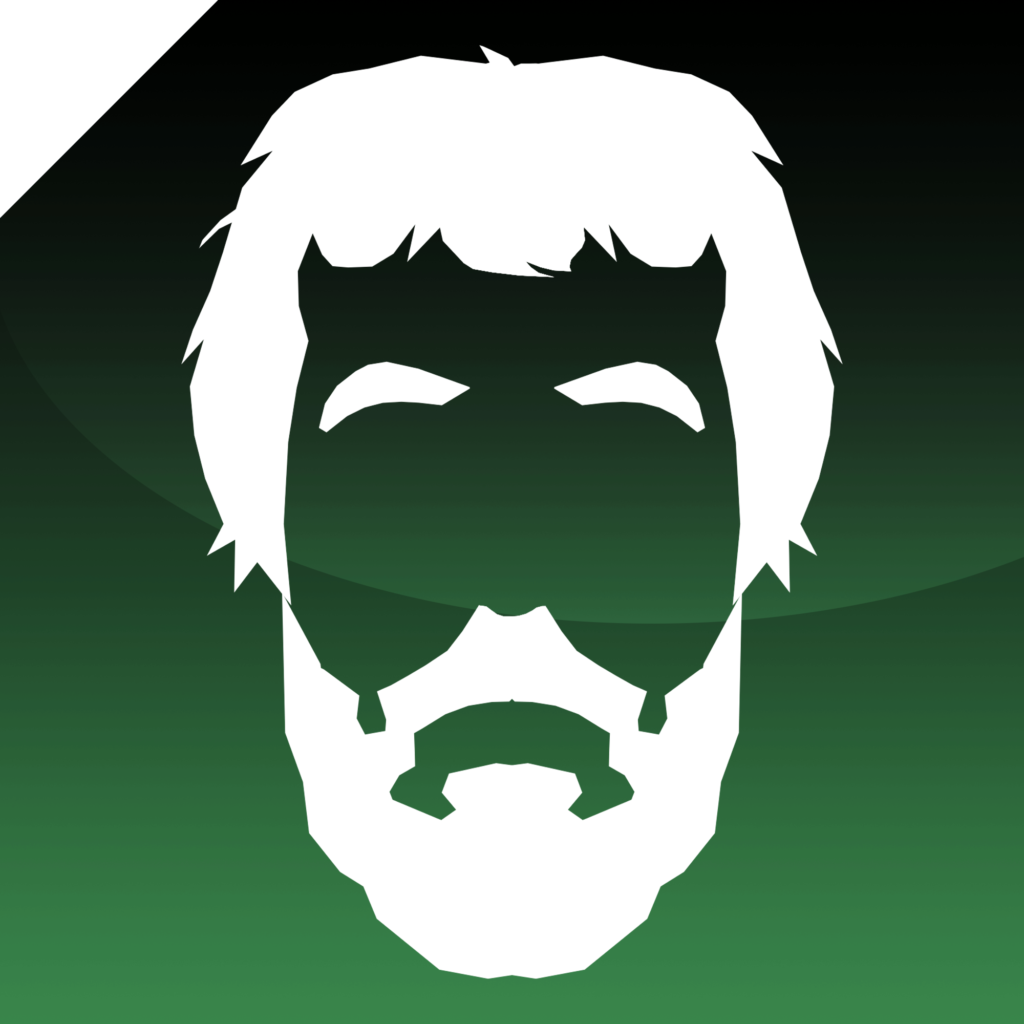
With this technical series, I’d like to share with the community on how we solved the problem of procedural generation of the environment for the arena.
When we started working on Light Trail Rush, we first imagined space ships racing inside a spherical arena, featuring two cities: the bottom part facing the upper part. Like so:
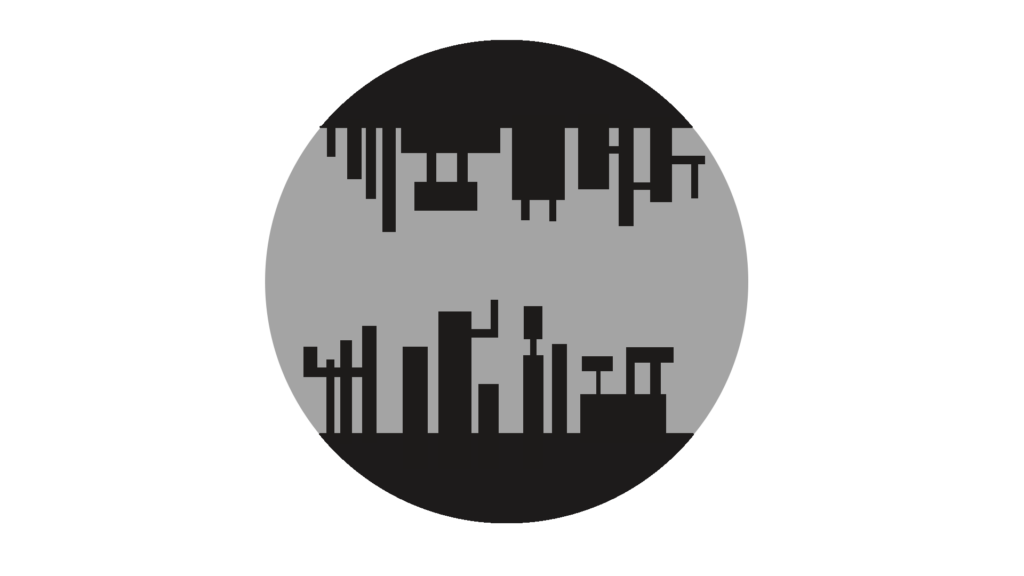
To begin the project, we explored a few solutions on how we could create the arena and we finally went for procedural generation:
We set out to use building sets to anticipate any need of districts or themed cities with different building sets.
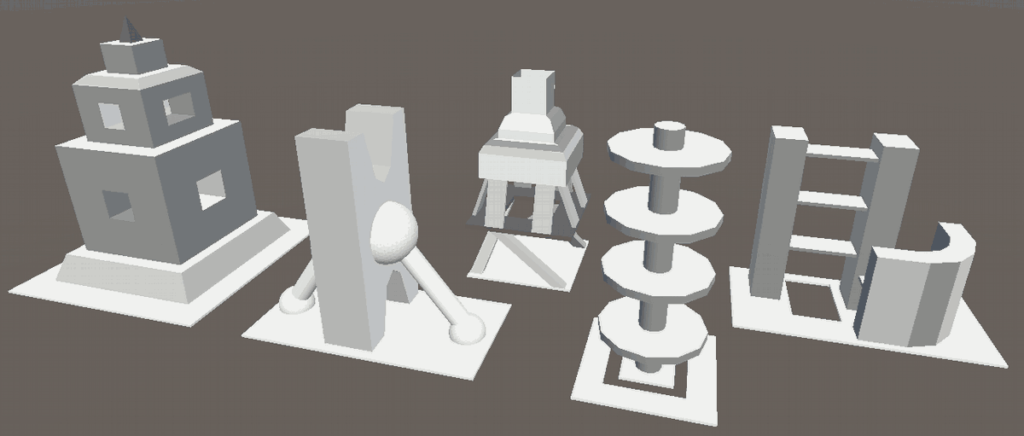
Then we developed a first procedural generation script to place those buildings on a grid.
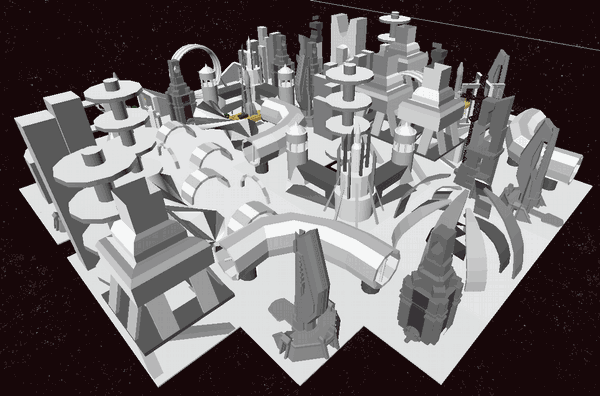
We had a starting point for the arena, but an element to support and anchor the city on top of it was necessary. While we developed the network side of the game, the game designer created a whole static arena so we could define the needed implementations to build a first playable version of the game.
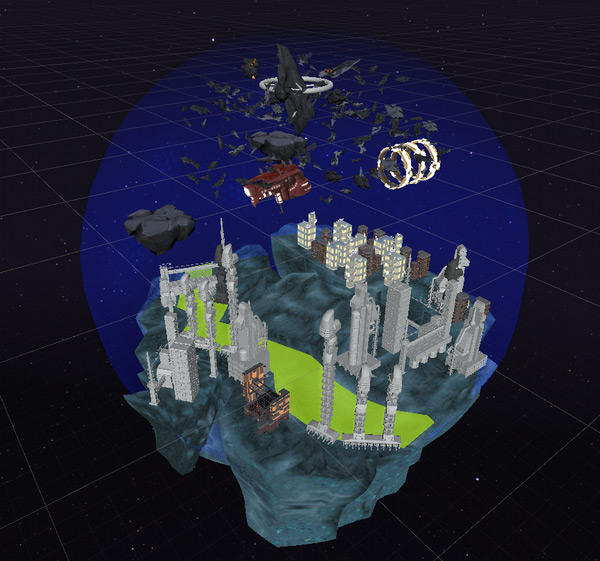
I was assigned on the procedural generation part of the game. I looked into ways of creating the asteroid where the city would sit upon. I wanted to go for a voxel-based terrain as it would open the possibility to modify the object while playing. It would, for example, allow to dig paths for the Tracer with a kind of drill.
The Unity Asset Store provided many terrain generation solutions. I browsed multiple Unity forum threads related to those plugins and my attention was drawn to Voxeland: a user had made a whole planet using the plugin:
It couldn’t be that hard to create asteroids if someone made a whole planet! So we took Voxeland and I started studying it.
Voxeland’s terrain is internally made of cubes. It uses a generator and various noises to iterate over a 3D matrix coordinates, setting each generated land block as byte into the matrix. This matrix is then materialized as Voxeland builds the terrain meshes. Finally, Voxeland’s shader renders proper textures for the land blocks, creating realistic landscapes.
The tool is great at generating mountains and hills, fulfilling its main purpose. However, its generator cannot create cavities, meaning we cannot create floating islands, though we still can sculpt the generated terrain to manually shape a floating object.
Considering the “floating” nature of an asteroid and all its cavities, it is impossible for the generator to create all the shapes and forms of the object.
I decided to build our own generator specifically to create asteroids. Reusing Voxeland’s 3D matrix, I combined its coordinates with a Perlin noise to define which cell would have a land block. With settings set on the lower end, it would generate lumps of land with more or less cavities.
From there, to generate one ellipsoidal objects to render an asteroid shape, I added a distance restriction from the centre of the matrix to its extends. A fractal noise on top of the Perlin gave a rougher surface to the object, making it looked more like a rock than an egg.
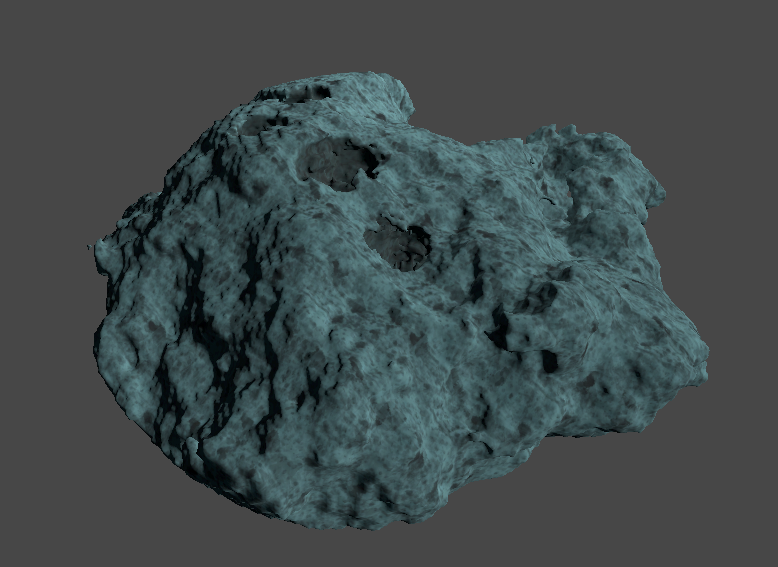
Our asteroids being large, we needed to use two layers of textures to render more details on close range. Working with the art team, we tried to use Voxeland’s shader to get a distance blending between the two texture sets. Unfortunately, due to performance issues, we had to look into an alternative solution. I set out to explore Voxeland mesh generation scripts to find how the textures were set and retrieved for each land type.
The land block bytes were encrypted in their corresponding vertex tangent upon mesh generation. The tangents were then decrypted by the shader used for the terrain, using the resulting bytes with a blending algorithm to smooth the texture transition between land blocks.
The team is used to create shaders with Amplify Shader Editor, so I transferred Voxeland decryption code into a custom Amplify node script. I could then add this node in an Amplify shader script, import Voxeland’s texture blending in an Amplify function and use the node output with the function to retrieve each land block blending. I then recreated Voxeland’s triplanar functionality with an Amplify triplanar node. I finally added the close textures over the far ones, multiplying the close textures with a camera distance factor. This would render the asteroid with a subtle texture tiling from afar and more details as we get closer to the surface.
It has been very pleasant to explore the Voxel technology, I’ve always been fascinated by its use in many games like 7 days to die, No man’s sky, Minecraft, Terraria…
It is intuitive to manipulate matrices to shape your objects, though you need a proper mesh generator to transform these matrices into models.
Here is what I drew from that experience:
The asteroids are now virtually tangible. In the next article, we will begin to place buildings and roads upon them to generate cities. We’ll further explore the algorithms that made the cities look the most natural.
For further research:
Voxeland forum : https://forum.unity.com/threads/voxeland-voxel-terrain-tool.187741/
Unity Store for Voxeland : https://assetstore.unity.com/packages/tools/terrain/voxeland-9180
Watch veteran Sylas come to life before your eyes with this drawing time lapse by Axel, concept artist.
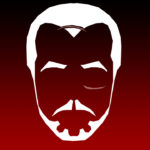
Making a game takes a lot of love and sweat.
As an indie dev, deadlines and crunches sometimes prevent us from taking a step back from tasks. So, we thought we’d sit down with team members and have them share their experience on making LTR, from a more personal perspective.
When I was small, I used to watch my dad painting anytime he got a chance. He’d paint copies of Miro and Picasso whom he admired a lot.
I would spend hours just watching him painting, the process was fascinating for the five-year-old I was.
I knew then I’d be an artist and the game element came when I was fifteen. I started playing the game Bioshock. The artistic direction was very strong, the game had great philosophy elements to it. The backdrop was an amazingly rich underwater world.
I’m quite lucky to make a living from my two passions. I spend a lot of time doing artistic research and experimenting in many ways of adapting my findings to our projects.
I’ve always been fascinated by sci-fi, so I lucked out working in a video game studio making a game I feel a connection to.
In my free time, I illustrate the album jackets for my musician friends.
I dream that one day I would lead a 2D animation project. I already have all the script in my mind, the story would be inspired by “the moon” by the Grimm brothers.
On LTR, as an illustrator-concept artist, the challenge is to create buildings in line with our retro-futurist concept. It was thrilling but tricky to find ways of integrating the gameplay to the environment.
The artistic team is currently working on a building-ship which is moving, floating in the environment. I created tunnels in the maintenance area and the exciting stuff is that players will use those tunnels in their gameplay, flying in and out of the tunnel.
Something I’m happy with is, as the universe features darker colours, and in 3D, I wanted to give more of an “animated and live” feel. I used 2D advertisement billboards which are drawn and are animated in order to bring more life. They’re great for carrying subliminal messages and leave the players the freedom of interpretation of the universe they’ll be playing in.
So far, it’s been a great work experience. I love playing the Maniability ship. The inspiration for its’ design came from Beyond the Void, our first title. In the BTV lore, the Hignos are an ethnic group living in an underwater world. I got the inspiration from them and created a ship design which has a shape of a prawn. It came out nicely. To me, Maniability ship is the best one to play with.
Each ship will have 4 parts which can be customized (ie: engines, wings, cockpits, reactors). I’m doing a lot of research on ship parts, this is my favourite part of the job at the moment. I love the versatility that customization permits. We have 4 ships so far but you can still create cool stuff using different combinations.
I’m secretly working on a level editor where all my co-workers are represented with avatars (I modelized each members portrait in 3D). The editor is from OverGrowth game.
I wrote a little story where we’re going to battle each other. But now the secret is out.
As an indie dev, deadlines and crunches sometimes prevent us from taking a step back from tasks. So, we thought we’d sit down with team members and have them share their experience on making LTR, from a more personal perspective.
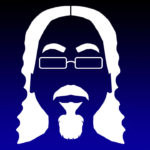
I feel like a craftsman, creating something from scratch. Thinking of it, it started when I was twelve. I fell deep into video games precisely when I started a free trial of “Game factory”.
It was exciting to have the freedom of building my own games, I never stopped.
What I like in my function is that I get to work with everyone on the team.
I spend most of my time programming on Unity. I’m in charge of the technical choices. And everything I deliver in regards to programming has to be in line with the art team and game design team. I make technically possible what was imagined by the creative team.
My favourite moments are when we run playtests.
Seeing the players’ interaction and how it evolves from build to build is exciting. It’s a privilege to make something that people can relate to and make their own. It’s amazing to see what was intended to work out quite well.
Early on, we had to find solutions for the environment and the gameplay which are procedurally generated. We had many questions in regards to performance and optimisation.
I watched many Unite conferences which gave us many ideas on mesh generation. I learned a lot on optimisation. LTR has a lot of 3D artwork, to be embedded, the code has to be performant.
The IA part was more complex than in conventional racing games. In LTR, the Tracer creates the track in real time. In the absence of a predefined circuit, the IA has to learn how to behave and drive on any given situation in real time.
We tested using Deep Learning, but we ruled it out, the results were not satisfactory. We ended up coding an in-house solution giving us a lot of freedom for adding and making needed changes according to the gameplay. We liked the flexibility of this in-house solution.
I love playing the Tracer especially with the new gameplay we’ve recently added. As a Tracer the gameplay is completely different from the Chasers.
Of course, it’s fun to design the most difficult tracks and trick your opponents into crashing. It’s even more exciting to drill your way into asteroids and earning points in the process.
In my free time, I paint miniatures from wargames. It’s a bit like in LTR, which features a garage where players can ‘pimp their ride’.